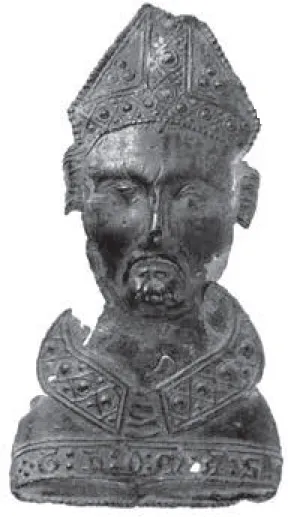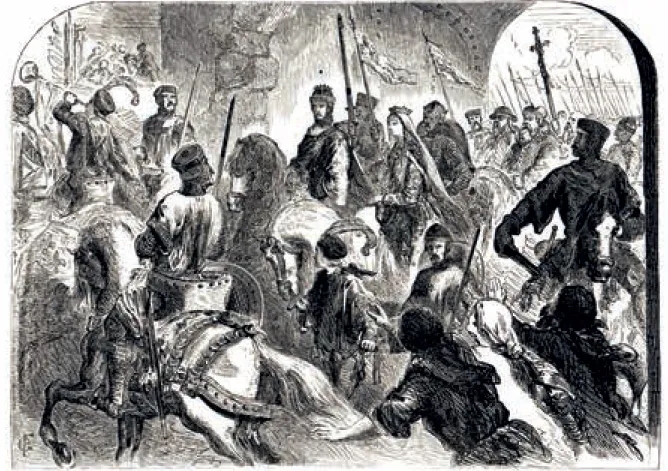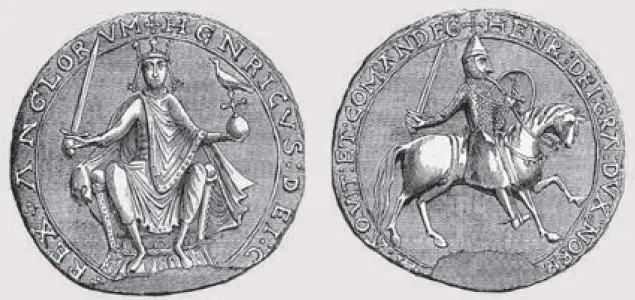![]()
Archbishop of Canterbury Thomas Becket is confronted by the four knights who famously took his life in the cathedral.
1
HENRY II
King Henry II is best remembered for the bloody murder of Thomas Becket, the Archbishop of Canterbury. By chance or mishap, Henry infamously caused four knights to slaughter the priest in Canterbury Cathedral by crying: ‘Will no one rid me of this turbulent priest?’
THE FIRST Plantagenet king never actually uttered the sentence about the ‘turbulent priest’. However, at the time, Henry was angry, drunk and tired after a long evening of feasting. What he actually said, moreover, was threatening enough. ‘What miserable drones and traitors have I nurtured and promoted in my household,’ he supposedly bellowed, ‘who let their lord be treated with such shameful contempt by a low-born cleric?’
Becket was indeed not of noble blood, but rather the son of a London merchant whose star was on the wane after a meteoric ascent through Henry’s court to the highest religious office of the land. Not that any of this mattered to the four knights who sat earnestly through Henry’s tirade and concluded it to be a direct order from their sovereign. They immediately set out at a hard gallop from Henry’s court in Bures, Normandy, to Canterbury and reached the cathedral a few days later.
Becket was in his inner chambers at dusk on 29 December 1170, when the heavily armed knights burst through his door. An argument broke out and Becket retreated, hurrying away to hear vespers. Now angry, the knights followed Becket into the cathedral and attempted to drag him outside. Becket resisted, crying out that if they wished violence upon him they would have to carry it out there, on consecrated ground. He grabbed a nearby pillar and held on for his life.
Henry II had inherited both the Plantagenet golden-red hair and the fiery temperament: his tantrums were legendary.
Swords were then drawn and Becket was struck with the flat of one knight’s sword. ‘Fly! You are a dead man,’ he told Becket as another dealt him a blow on his head. Blood streamed down Becket’s face and he fell to his knees. Another knight then swung at Becket with such force that he cut off the top of his skull and shattered his blade against the stone floor. The others proceeded to butcher Becket where he lay, one using his sword point to spread around the Archbishop’s brains. He then called out to his comrades: ‘Let us away, knights; he will rise no more.’
Standing in stunned silence in the shadows of the cathedral were Becket’s ecclesiastical staff. These were the men who would report the atrocity to the horrified ears of European Christendom. None were excluded from the appalled condemnation of Henry that followed. Louis VII of France, who had earlier lost his bride Eleanor to Henry and hated him passionately, demanded ‘unprecedented retribution’. ‘Let the sword of Saint Peter unleashed to avenge the martyr of Canterbury,’ Louis wrote.
The Becket Casket is a 12th-century gilt-copper and champlevé enamel reliquary depicting the murder of the Archbishop. Its contents are no longer present.
It would take three years for Becket to be canonized, but in the meantime his martyrdom was an instantaneous scandal. The people of Canterbury rushed to the murder scene waving pieces of cloth that they dipped in his blood and then tasted, and in some cases, put into their eyes. Sensing the possibilities, the priests of Canterbury immediately struck up a thriving trade in Becket’s blood. It was gathered and mixed as a tincture, heavily diluted with water, and sold in small, custom-made alloy vessels with the inscription ‘All weakness and pain is removed, the healed man eats and drinks, and evil and death pass away.’
This badge of Thomas Becket’s head was a common souvenir sold to pilgrims visiting his shrine at Canterbury Cathedral. The badge proved that the pilgrim had made the journey and was said to heal the sick or dying.
For those not able to afford a vial of Becket water, brooches and pins depicting the Archbishop’s likeness also became available. A kind of cult of Becket was created and pilgrims with mysterious ailments including cankerous sores and swollen limbs made long pilgrimages to his tomb. Chaucer’s The Canterbury Tales is based on these pilgrims. Any member of the unwell who did not receive a healing miracle via the dead Becket was simply told they lacked the inherent faith to begin with. Nothing would slow the multitudes of pilgrims or the publicity it generated for Becket’s martyrdom; news of his murder spread quickly.
The irony was that Henry seemed as shocked by the news of Becket’s death as everyone else. After all, they had once been favourite friends. But more than that, Henry understood exactly what the fallout from the murder would entail: it would leave him as a pariah. He took to his bed for three days and refused food or water. He then set off for the furthest corner of Western Europe where he could stay out of view: Ireland.
THE KING’S BEGINNING
The Kingship of England had been one trial after another from the moment Henry, Duke of Normandy and Count of Anjou, took the throne at 21. Henry inherited his father Geoffrey of Anjou’s golden-red hair and a propensity for violent and vindictive rages. During one such fit, Henry ‘flung down his cap, undid his belt, threw from him his cloak and robes, tore the silk covering off his couch, and, sitting down as if on a dunghill, began to chew stalks of straw.’
Volatile and unpredictable anger was the characteristic that united all of the Plantagenet kings. On the one hand, Henry could be charming and held the wit and courtly courtesy expected of a medieval royal; he also dressed like a huntsman and was quick to take violent offence if he believed his authority undermined.
Henry was ruthlessly ambitious and his mother Matilda had urged him from boyhood to seize his birthright of England. In his wife, Eleanor of Aquitaine, Henry had met an equal in ambition: the union brought great wealth to both parties and was also one of the great royal scandals of the age.
The traditional role of princesses during the Middle Ages was to be married off as a way of brokering an alliance between two great households. This could increase the wealth and assets of both or otherwise heal a rift that had previously resulted in conflict. Eleanor, however, was a rare combination of a keen brain and captivating beauty; medieval students in ale houses often sang bawdy songs about bedding her. Eleanor’s lands of Aquitaine, which covered a vast swathe of western France, were prize enough in themselves for any royal suitor. Eleanor was, in short, the greatest catch of the 12th century.
VOLATILE AND UNPREDICTABLE ANGER WAS THE CHARACTERISTIC THAT UNITED ALL OF THE PLANTAGENET KINGS.
King Louis VII of France wasted no time in marrying Eleanor himself, but the union was to be a disappointment for both newly-weds. Eleanor bore Louis two daughters but was unable to produce a needed male heir. Besides, Eleanor was a feisty, extravagant queen who loved luxury. Louis, by comparison, dressed drably and stuck to a simple diet. Eleanor once remarked: ‘I’ve married a monk, not a monarch!’ In the end, it was Eleanor who sought an annulment from Louis. To add insult to this injury, Eleanor was soon riding to the bedside of her next betrothed: Henry. The journey was dangerous, as several nobles had set out to kidnap Eleanor and force her into marriage, so desirable was her hand.
Eleanor’s marriage to Henry brought experience and sophistication to match the Plantagenet brawn: Eleanor was 30, Henry 19, and both wanted the world. With their territories combined and the lands later conquered by Henry, the couple would rule over a kingdom that stretched from Scotland to the Pyrenees; it represented the height of the Plantagenets' physical dominion. Eleanor’s ambition, however, would prove to be Henry’s undoing.
Henry II and Eleanor are depicted riding into Winchester on their way to the king’s coronation in London.
Nevertheless, when Henry landed on the shores of England to claim the English throne and quell the civil war that had wracked the country for 16 years, it must have been a comfort to know Eleanor was standing steadfast beside him. England at that time was not a particularly desirable proposition. Henry landed at Malmesbury in Wiltshire, a town loyal to his enemy, King Stephen, with a small army numbering around 3000 infantry and 150 knights.
Henry’s winter crossing of the English Channel had been tempestuous, and he marched towards Malmesbury in a filthy mood. The castle itself was half-ruined after three years of siege. Inside, the exhausted inhabitants prepared, once again, to defend their town as Henry planned how to destroy it. The Gesta Stephani, a history of King Stephen, recounts the action:
‘So the Duke [Henry] collecting his forces, and with the barons flocking in eagerly to join him, made without delay for the castle of Malmesbury, which was subject to the king, and when a crowd of common people flew to the wall surrounding the town as through to defend it he ordered the infantry, men of the greatest cruelty, which he brought with him, some to assail the defenders with arrows and missiles, others to devote all their efforts to demolishing the wall.
When the town of Malmesbury was captured…behold, not long afterwards the king [Stephen] arrived with a countless army collected from all his supporters everywhere, as though he meant to fight a pitched battle with the duke, as the armies of both sides stood in array with a river dividing them it was arranged between them and carefully settled that they should demolish the castle, both because they could not join battle on account of the river and ...






